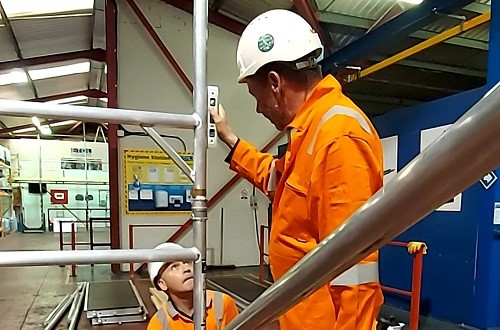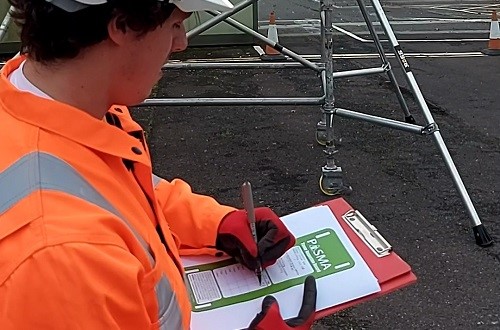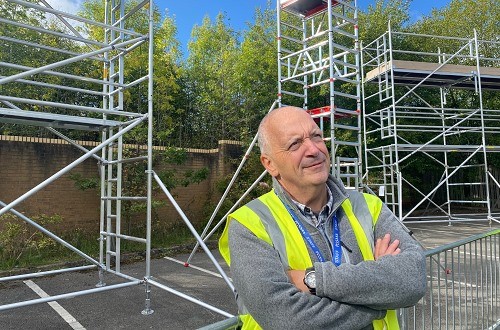Mobile access towers are a common type of work at height equipment, but it’s essential they are regularly and properly inspected to ensure they are safe to use.
Features
Get them inspected
Mobile access tower (sometimes called a scaffold tower) is only safe to use if it’s been assembled correctly. But how can you be sure it has? Before work begins, take a step back and check the completed structure.
Not only is this a requirement of the Work at Height Regulations 2005, it’s also a crucial part of tower safety.
By taking a few minutes to double-check everything is as it should be, you have the chance to resolve any issues before they become a problem.
 Operatives checking a tower. Photograph: Craig Gorton
Operatives checking a tower. Photograph: Craig Gorton
When should a tower be inspected?
Tower components can become damaged or worn over time, so they should always be checked to make sure they’re in good working condition before the tower is assembled. If all is well with the component checks, then the assembly process can begin. Inspecting the completed structure on site is the final stage in the process, so never start using the tower before doing it.
However, just because a tower was stable and structurally sound before it was first used doesn’t mean it will stay that way until the job is done. That’s why towers must be inspected as often as necessary to ensure their safety. How often this happens will depend on your risk assessment, but inspections should always take place:
- After assembly and before use
- After alteration and before re-use – for example, if you change the height of the tower or working platform level
- After any event that could affect safety – such as high winds, a change in ground conditions, or the tower being struck by something
- At least every seven days.
It isn’t necessary to re-inspect a tower every time it’s moved unless something happens during the move that could have affected its safety.
 Tower inspection in progress. Photograph: Craig Gorton
Tower inspection in progress. Photograph: Craig Gorton
If you plan to use a tower someone else assembled, check that it has an up-to-date inspection report first. If you’re in any doubt, it should be inspected again to be on the safe side. If you aren’t competent to do it yourself, ask someone who is to inspect it for you.
Who can inspect towers?
You can only inspect a tower if you have the required training, skills, knowledge and experience.
Operatives can learn to build and inspect standard single-bay mobile access towers on a PASMA Towers for Users training course. These towers are covered by the design standard BS EN 1004-1.
If operatives are building and inspecting other configurations of tower scaffolds – such as cantilever towers, towers on stairways, linked towers or towers with bridges – there are separate, dedicated PASMA courses for these. These towers are all covered by the design standard BS 1139-6.
Managers and supervisors can learn to inspect any standard configuration tower on a PASMA Towers for Managers course. This course is aimed at those who are responsible for the safety of tower users but aren’t assembling towers themselves.
How can an inspection be recorded?
You must record the details of your inspection, including all eight pieces of information listed in the Work at Height Regulations, such as the location and a description of the work equipment, any risks identified, and the date and time of inspection.
The inspection report must be provided to the person for whom it was completed – for example by attaching a copy to the tower. The report should be accessible to anyone using the tower, available on site until the tower is dismantled and then kept safe for a further three months. This is a legal requirement.
How to inspect a tower
Even if you are competent, you can’t inspect a tower properly without the instruction manual. You must always have a copy on site anyway, so before you do anything else, go and get it.
 Don Aers watching towers being built. Photograph: PASMA
Don Aers watching towers being built. Photograph: PASMA
With the manual in hand, inspect the completed tower from the ground, working through this checklist:
1. Are the ground conditions suitable, all castor brakes locked and wheels in contact with the ground?
2. Is the tower level and upright and are the adjustable legs set correctly but not used to gain extra height?
3. Is the tower stabilised as per the instruction manual, using the correct stabilisers or outriggers, or the correct type and position of ballast, or is the tower tied in using the right type of ties in the right position?
4. Are the horizontal and diagonal braces positioned and secure as per the instruction manual?
5. Are all frames of the correct size and type, in the correct position with locking devices secured?
6. Are all platforms positioned correctly with trapdoor openings over the built-in access and all windlocks engaged?
7.Do all platforms have double guardrails on all sides, fitted as per the instruction manual?
8.Are toeboards correctly fitted as per the instruction manual?
9.Is the tower the correct height for the task?
Note: this checklist applies to EN 1004-1 mobile access towers only. If you’re inspecting a different type of tower, there are different things to check.
If you spot a problem, stop – don’t use the tower. In a worst-case scenario, a tower that hasn’t been assembled correctly could topple over or collapse, so don’t let anyone use it.
If you can’t fix the issue straight away, display a warning sign at the access point, physically restrict access (for example, using barriers) and report it to a manager.
Only when you’ve ticked every point on the checklist can you be sure your tower is structurally sound and contains all the essential components that keep operatives safe. Now you can start using the tower!
For more information see: pasma.co.uk
Tower safety videos – free resource!
Using Towers Safely in Rail Environments is a series of 10 short videos for tower operatives in the rail sector.
They were created for the industry by PASMA, Taziker and Network Rail to improve safety for everyone who uses towers to work at height on the railway, although any sector will find them useful. The videos cover key areas of tower safety, including inspections.
Safety professionals are encouraged to watch, learn, share and – most importantly – use these videos freely to support tower safety in their own workplace and to remind operatives of their PASMA training right when they need it most.
Watch the videos on PASMA’s YouTube channel: youtube.com/pasmaltd
TowerSure by PASMA – the smarter way to manage tower inspections
There’s a lot to remember when it comes to inspections – from the parts to be checked to what to record on the report. Throw in time pressures, distractions and unexpected on-site challenges, and the operatives who build and inspect the tower can make mistakes that managers won’t always pick up on.
That’s why PASMA developed TowerSure, a new mobile app and online portal that makes it easier to get it right. It guides operatives through tower inspections, helping them ensure all safety checks are completed and all legal responsibilities are met along the way.
It makes the whole process more reliable and insightful – not just for operatives, but also for their managers and clients.
How does it work?
Operatives use the free TowerSure mobile app to complete inspections. Meanwhile, their managers log into an online console to view inspection records and photos of the towers. The online console allows managers to see their whole network of towers, wherever they are on site or in the country, without leaving their office.
The system automatically creates online inspection records, so it replaces hard copy records – ensuring inspections are consistent while saving time (and the environment).
“Our site managers like TowerSure because it simplifies their job. They don’t have to go back to the office and fill out a load of paperwork, it’s all done on their phone there and then,” says Sam Beesley, HSQE manager at AT Jones Group, who pilot-tested TowerSure for PASMA before rolling it out more widely across their specialist drywall and facade business.
The technology allows anyone on site to scan a QR code on the tower’s TowerSure label for quick and easy access to the inspection record. Operatives might do this before using the equipment themselves and clients may want to spot-check if inspections are being carried out on schedule.
Features that build confidence in the towers
With TowerSure you can:
- Ensure consistent, thorough tower inspections with built-in PASMA checklists for every tower
- Check competence against PASMA training records, automatically
- See photos of all towers on your sites and projects
- Create, store, search and share tower inspection records electronically
- Identify common mistakes happening in the business and use them as a learning tool.
“If you’re trying to develop a positive safety culture, TowerSure is a great opportunity to do that,” says Blake May MChem CMIOSH, a safety and health practitioner who helped pilot TowerSure. “It gives you a tool to review previous tower inspections and build learnings based on evidence of what’s going on in your business.
“It’s really, really important to be able to see how your staff are performing so you can go back and get those learnings and produce targeted toolbox talks, briefings or use some of the videos that PASMA has created.”
Official launch
TowerSure was officially launched at PASMA Conference 2022 in Nottingham, where delegates had the opportunity to inspect the equipment on display and check the inspection records on their phones.
The system is now freely available to all organisations, large and small, that are looking to take their next big step in improving tower safety on their sites.
To try TowerSure, visit: www.pasma.co.uk/towersure
Don Aers is technical director at PASMA
FEATURES

Sedentary working and how to combat the ‘sitting disease’
By Gavin Bradley, Active Working on 05 April 2024
Prolonged and excessive sitting poses a major risk to our health, but the Get Britain Standing campaign and On Your Feet Britain Day on 25 April are a great way of encouraging workers to sit less and move more.

Company culture and wellbeing: a crucial link
By Bex Moorhouse, Invigorate Spaces on 05 April 2024
Investing in measures to support worker wellbeing will be ineffective unless the company culture genuinely incorporates values like teamwork, involvement, flexibility and innovation.

Office design and culture: happier and healthier staff – or the opposite?
By Guy Osmond, Osmond Ergonomics on 03 April 2024
Applying ergonomic principles to workstation set-ups and ensuring the physical environment supports neurodivergent people are just some of the ways of creating an office where everyone can thrive, but a supportive and positive organisational culture is vital too.


